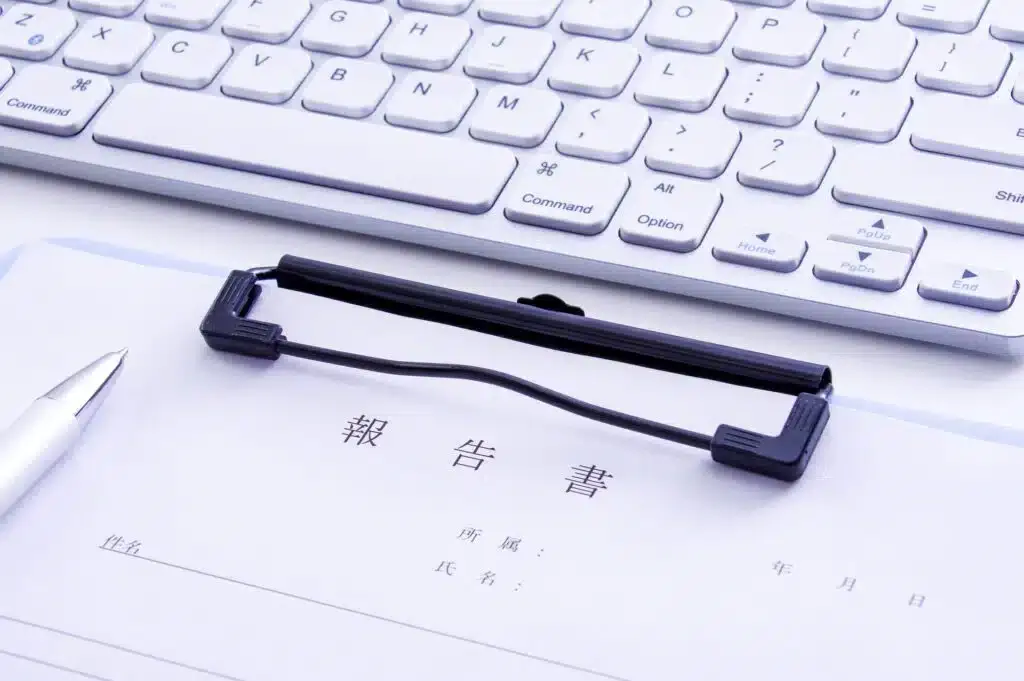How to Write a Warning Letter When You Discover a Trademark Infringement

If there are products or services infringing on your company’s trademark rights, the rights holder can demand the cessation of its use and claim damages based on these rights. While it is possible to resolve this through a lawsuit or provisional measures via the Trademark Infringement Court, it is common to first send a ‘warning letter’ out of court.
This warning letter can be created and sent by the rights holder themselves, or they can request a specialist to create and send it on their behalf. In recent years, trademark infringement in listing advertisements has also become a significant issue, and the basic measures in this case are the same.
Gathering Information for Sending a Warning Letter
Even if a registered trademark is being used, it does not necessarily constitute trademark infringement. Before sending a warning letter, it is crucial to carefully consider whether the situation truly constitutes trademark infringement. This article will not go into detail, but a trademark right does not prohibit the general use of the trademark you have registered. What can be prohibited is strictly the “trademark use”, which is limited to usage that meets certain conditions.
In order to determine whether a trademark right is actually being infringed, first gather and organize information about your company’s trademark rights and the other party’s products/services.
About Your Company’s Trademark Rights
Even if the same name is used for a product/service, it does not constitute trademark infringement if the classification is different. Before creating a warning letter, gather information about your company’s trademark rights and thoroughly confirm the scope of the rights of the registered trademark.
- Registration number
- Expiration date of the right
- Trademark
- Contents of designated goods/services
Although it is a rare case, it is possible that the trademark right has been extinguished because the payment of renewal registration fee was forgotten. Therefore, always check the expiration date of the right. Also, you need to understand your company’s actual use of the trademark. This is because you cannot register a trademark that is not actually used in business, and even if it is a registered trademark, those without actual use are not protected.
Anyone can request a cancellation trial for a trademark that is not actually used, and it cannot be denied that the situation may escalate to the point where the other party claims non-use cancellation of the trademark and requests a trial due to the sending of a warning letter. At the stage of information gathering, do not neglect to confirm whether your company truly owns the rights to the registered trademark.
Information about the Other Party’s Products/Services
In order to consider whether it truly constitutes an infringement of rights, it is necessary to gather information about the product that is believed to be infringing the trademark right. From the product itself, product packaging, catalogs, advertisements, website information, etc., you must properly confirm what is being sold and how. Also, in case legal procedures have to be taken if the warning letter does not resolve the issue, keep each piece of information as evidence, including information about the other party’s business content/range and profits.
Identifying the Infringer
In order to send a warning letter, you need to know where to send it. Before creating a warning letter, check if you know the other party’s contact information.
Especially in the case of products sold on the Internet, there may be cases where the identity of the seller of the product infringing the trademark right cannot be identified. Vendors selling products on the Internet are obliged to display their name, address, and contact information based on the Specific Commercial Transactions Act, but there are quite a few cases where false content is displayed or no display is made at all.
If you don’t know who or where the trademark infringer is, you can’t send a warning letter. Also, if the other party’s name or address is unknown, it is difficult to take legal measures such as filing for a provisional disposition or lawsuit against the seller. In such cases, there is also a method of requesting disclosure of sender information from the operator of the shopping mall site selling the trademark-infringing product or the rental server of the sales site based on the Provider Liability Limitation Act.
Also, if the other party is using a unique domain, there may be cases where the other party can be identified from the whois information.
The Format and the Ways to Write a Warning Letter
Warning letters are typically sent via certified mail or regular mail. The method of mailing and the title of the document should be determined based on the nature of the trademark infringement. If the infringement is severe, a “Warning Letter” should be sent via certified mail. If the use was not intentional and a peaceful resolution is expected, a business letter-style “Contact” or “Notice” can be sent via regular mail.
However, please note that some malicious online operators may use fake addresses. Even when using regular mail, it is desirable to use a trackable mailing method such as registered mail or delivery confirmation mail to ensure receipt of the warning letter.
In cases where it’s not a big deal and you just want them to stop using the trademark, you may send a warning via email. However, compared to when a certified mail is sent by a professional acting as an agent, there is a higher chance of being ignored. Therefore, if you want a sure response, you should send a warning letter in writing.
Contents to be Included in a Warning Letter

There is no specific format for a warning letter. However, at the very least, you should include the following items:
Information Identifying Your Registered Trademark
- Registration number
- Content of the trademark
- Designated goods and services
Which of the Recipient’s Actions Constitute Trademark Infringement
In this section, based on the results of your prior investigation, you should primarily write about “how the trademark the recipient is using is similar to your registered trademark” and “how the recipient’s industry is identical or similar to your designated goods and services”. Try to explain as concretely as possible why these actions constitute trademark infringement so that the recipient can understand.
Demands to the Recipient
Here, you should specify what kind of response you want from the recipient regarding the trademark infringement.
Basically, you will demand that they cease using the trademark.
If the damage from the trademark infringement is significant, you may also consider demanding compensation for the damage suffered due to the use of the trademark, requesting the return of profits obtained through the unauthorized use of the trademark, or demanding public apology and reputational recovery measures for the damage caused to your brand by the unauthorized use of the trademark. If you are willing to allow the use of the trademark in exchange for a reasonable fee, you could mention that you are prepared for a license agreement and guide the recipient towards negotiating such an agreement.
Method and Deadline for Response
Don’t forget to set a deadline for the response. The recipient will need time to consider whether the matter truly constitutes trademark infringement and may not be able to respond immediately. If you set a deadline in advance, they should send a response if they find it difficult to reply by that time. It is very important to specify a response deadline, not only to request a prompt response, but also to determine whether the recipient intends to respond or is simply ignoring the warning letter. It is common to note that if there is no response by the deadline, you are considering legal action or criminal prosecution.
Negotiations After Sending a Warning Letter
After sending a warning letter, your response will vary depending on the recipient’s reaction. Therefore, depending on whether or not there is a response and its content, you will need to consider subsequent negotiations.
If There is a Response
The recipient will read the warning letter and, after considering whether it constitutes a trademark infringement, will send a response.
In cases where the registered trademark was used unknowingly, there are often instances where they quickly comply with our demands.
Conversely, if the other party argues that they do not acknowledge the trademark infringement, you will need to re-examine whether there are any flaws in your claim of rights infringement. If both parties’ claims conflict, consider the option of initiating civil or criminal litigation. Legal proceedings can be costly and labor-intensive, so careful judgment is required as to whether or not to transition to legal measures, considering the likelihood of winning, the other party’s financial resources, the necessity of litigation, etc. Including negotiations on settlement money and licenses, deciding how to respond to the other party’s answer is a difficult problem that must be considered on a case-by-case basis. If the other party shows an uncooperative attitude and the issue is not easily resolved, it is recommended to seek the help of a specialist.
If There is No Response

If you have sent a warning letter but there is no response within the specified deadline, you should resend the warning letter just to be sure.
In reality, in the case of warning letters created in the name of a patent attorney or lawyer, it is often the case that the other party cannot ignore it. If the other party seems to be ignoring the warning letter, it would be better to ask a professional to create and resend it, as there is a higher chance of getting some kind of response.
If there is still no response to the re-sent warning letter, you will need to consider litigation, etc.
While these flows and specific methods of initiating litigation vary depending on the manner and scene of trademark infringement.
Conclusion
Some may hesitate to send a warning letter, wishing to avoid any disputes. However, in most cases, trademark infringements occur unintentionally and without knowledge. Therefore, it can be said that if a warning is issued at an early stage, the other party is likely to respond smoothly. If you continue to ignore the situation without issuing a warning, the other party may not easily cease the use of the trademark. Therefore, it is advisable to promptly send a warning letter once a trademark infringement is confirmed.
However, this does not mean you should rush to resolve the issue and neglect to consider whether it truly constitutes a trademark infringement. If there are flaws in the claims made in the warning letter you sent, it could lead to trouble with the other party. Therefore, it is important to make a careful judgment. If you wish to send a warning letter for trademark infringement, we recommend considering hiring a lawyer not only in preparation for potential negotiations or litigation, but also to ensure a swift and certain resolution.
Category: General Corporate
Tag: General CorporateIPO





















